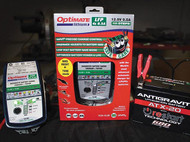Selecting A Lithium Ion Battery Charger
Posted by Dan Doyle on 9th Jan 2020
Not all motorcycle battery chargers are created equal…
I just want to start off by saying that I’m not an electrical engineer, so some of what I’m saying might be over-simplified. The intention of this is to provide you with enough information to pick out a charger for your lithium-ion battery. Let's go over some commonly asked questions I get.
“What charger should I use?”
There are two answers to this question. The first is, A LITHIUM CHARGER AND ONLY A LITHIUM CHARGER! I cannot stress this enough. The second is, ANY TECMATE CHARGER THAT WILL RECOVER A ‘LOW BATTERY’.” This includes the TM-471, TM-291 and TM-271 lithium-ion chargers.
Not all lithium chargers are created equal and the Tecmate line is no exception. They offer fully automatic, plug-n-play chargers designed for 12 volt and 16 volt lithium batteries. The TM-271 is designed to work with 12 and 16 volt lithium batteries.
The difference between these chargers and other chargers on the market is that these chargers will test, balance, charge and then re-test the cells once they have cooled down. After the cells are charged they tend to hold heat, which will actually give a false, higher voltage reading, so the charger will test the cells again once they’ve cooled down to give you an accurate reading.
“Why can’t I just use a trickle charger?”
When most people use this term it generally pertains to a lead-acid charger. Lead-acid trickle chargers will essentially try to ‘top-off’ the battery. This is fine for a lead-acid battery because it can handle it. If you do that with a lithium battery, however, you’re going to give the cells too much voltage, causing them to swell and fail, leaving you stranded; not fun. Lithium batteries don’t like seeing voltage spikes above 14.6 volts.
“What about ‘standard’ lithium chargers?”
These chargers are better than no charger at all, but keep in mind that they are designed to ‘maintain’ lithium batteries. This means they’ll keep the charge at a certain level. So, if you’re good about throwing your battery on a charger (if the bike is going to sit for extended periods of time) then this charger will be fine. I used one of these chargers on my lithium battery on my CX500 for about 3 years without any issues. BUT! If you happen to run your battery down, this charger will not pull you out of the mud. I always recommend the TM-471 at the very least. It’s cheap insurance for your fancy new lithium battery.
“Ok. Which Tecmate charger should I go with?”
Assuming you have a 12 volt lithium battery, that really all depends on the ‘size’ or ‘capacity’ of the battery. If you have a larger capacity battery (ex. V-Twin, Car, Truck), I usually recommend going with a charger that has a faster charge rate. I would also recommend going with a faster charger for those of you running a total loss system in a race bike.
- TM-471 charge rate - .8 amp/hours
- TM-291 charge rate - 5 amp/hours
- TM-271 charge rate - 9.5 amp/hours (12 volts) 7.5 amp/hours (16 volts)
Example:
The smaller TM-471 has a charge rate of up to .8 amp hours. That means that it can provide your battery with up to .8 amps per hour. For all intents and purposes, let’s say that you have an AG-801 with an amp hour capacity of 9 amps and you kill the battery. It would take the TM-471 charger over 11 hours to fully charge the battery at .8 amps/hour. That time does not include the time it takes to test the cells both before and after the charging process.
Here’s a simplified version of the math:
- TM-471 charging a 9 amp/hour battery
- (Capacity of battery) 9 amps / (Charge rate of charger) .8 amp /hours = (total charge time) 11.25 hours
If you use the larger TM-291 charger, which offers up to 5 amps/hour, it would take less than 2 hours to charge the same battery.
- TM-291 charging a 9 amp/hour battery
- (Capacity of battery) 9 amps / (Charge rate of charger) 5 amp /hours = (total charge time) 1.8 hours
Using the same equation, it would take the TM-271 less than one hour to charge the same battery.
Disclaimer:
If you drain your lithium battery down to zero volts, it’s done. Any lithium battery testing lower than 8 volts means that you should cross your fingers because those cells are most likely damaged beyond repair. That being said, this is not normally the case. In most situations, the battery is a bit low and just needs to be brought up to snuff.
I hope this helps. Feel free to reach out by visiting our Contact Us page if you have any further questions about lithium batteries and lithium accessories.


